Do you have a question about the PREVOST XL Series and is the answer not in the manual?
Identifies the ignition switch key.
Identifies the tachograph key.
Identifies the lavatory door lock key.
Identifies the entrance door lock key.
Identifies the baggage compartment door lock key.
Identifies the front electric compartment door lock key.
Identifies the steering compartment lock key.
Identifies the rear service compartments door lock key (XL-45).
Identifies the main power compartment door lock key (XL-45).
Identifies the video system compartment door lock key.
Identifies the toilet tissue dispenser key.
Identifies the moist towel dispenser key.
Identifies the video monitor lock key.
Notes on remote locking of baggage doors via central system.
Manual switch for connecting/disconnecting 12/24V systems on XL-40.
Toggle switch for disconnecting 12/24V systems on XL-45.
Caution on setting battery disconnect switch to OFF for extended periods.
Note on electrical supply exceptions when battery disconnect is OFF.
Accessing the fuel filler neck on XL-40 vehicles.
Accessing the fuel filler necks on XL-45 vehicles.
Caution regarding filling the fuel tank to 95% capacity.
Identifies the Left Hand Side Control Panel.
Identifies the Left Hand Lower Switch Panel.
Identifies dashboard instruments without tachograph.
Identifies dashboard instruments with tachograph.
Identifies the Right Hand Lower Switch Panel.
Identifies the Right Hand Console.
Identifies the Detroit Diesel PRODRIVER™ Controls.
Identifies the Right Hand Lateral Console.
Operation of the adjustable air louvers.
Controls for engaging and setting cruise control.
Operation of the optional baggage door lock.
Operation of transmission or engine retarder systems.
Control for the destination sign illumination.
Switch for heating exterior mirrors.
Powers the optional chime system for passenger requests.
Switches on the overhead lights above the driver.
Controls for interior fluorescent lights.
Controls for reading lamps.
Controls for aisle dome lights.
Adjusts vehicle height for kneeling or high-buoy.
Energizes the galley's electrical circuit.
PA system microphone jack.
Adjusts left-hand side exterior mirrors.
Adjusts right-hand side exterior mirrors.
Connector for diagnostic data link.
Overview of the automatic speed control system.
Procedure for setting desired cruising speed.
Methods to increase the set vehicle speed.
Methods to decrease the set vehicle speed.
Methods to disengage cruise control while retaining memory.
Note on speed limitations and system inoperability.
Warning regarding toggling SET or RESUME switches.
Lights for Kneeling/Hi-buoy/Low Buoy systems.
Indicates when to drain diesel fuel filter/water separator.
Indicates tag axle unloading or retraction.
Illuminates when the lavatory door is locked.
Lights when the parking brake is applied.
Flashes for left turn signals or hazard warning.
Lights when primary system air pressure is too low.
Flashes for right turn signals or hazard warning.
Lights when headlight high beams are selected.
Indicates alternator function and battery balance.
Indicates battery voltage outside normal range.
Displays engine coolant temperature.
Displays engine oil pressure.
Displays transmission oil temperature.
Displays turbo boost pressure.
Displays air pressure in primary and secondary systems.
Displays differential oil temperature.
Indicator for electrical systems (XL-45) or dummy (XL-40).
Lights if baggage compartment doors are unlocked.
ABS indicator behavior and malfunction indication.
Indicates when transmission shifting is prohibited.
Indicates low fuel level and recommended action.
Indicates when the preheating system is turned on.
Indicates when the transmission's output retarder is activated.
Lights when brakes are activated.
Indicates minor engine malfunctions detected by DDEC.
Indicates major engine problems leading to automatic shutdown.
Lights for Kneeling/Hi-buoy/Low Buoy systems.
Indicates when to drain diesel fuel filter/water separator.
Indicates tag axle unloading or retraction.
Illuminates when the lavatory door is locked.
Lights when the parking brake is applied.
Flashes for left turn signals or hazard warning.
Lights when primary system air pressure is too low.
Flashes for right turn signals or hazard warning.
Lights when headlight high beams are selected.
Indicates alternator function and battery balance.
Indicates battery voltage outside normal range.
Displays engine coolant temperature.
Displays engine oil pressure.
Displays transmission oil temperature.
Displays turbo boost pressure.
Displays air pressure in primary and secondary systems.
Displays differential oil temperature.
Indicator for electrical systems on XL-45.
Lights if baggage compartment doors are unlocked.
ABS indicator behavior and malfunction indication.
Indicates when transmission shifting is prohibited.
Indicates low fuel level and recommended action.
Indicates when the preheating system is turned on.
Indicates when the transmission's output retarder is activated.
Indicates major engine problems leading to automatic shutdown.
Indicates minor engine malfunctions detected by DDEC.
Records speed and engine data over 24 hours.
Indicates coach speed in MPH or KM/H.
Indicates engine speed in RPM.
Operation and setting of the vehicle clock.
Displays current vehicle speed.
Records the distance traveled by the coach.
Description of the four ignition switch positions.
Blank space for an additional switch on XL-40.
Operation and caution for the XL-45 battery master switch.
Engages fast idle for extended stops; caution on idling.
Procedure for inserting and using the tachograph diagram chart.
How to adjust the brightness of dashboard indicators.
Activates all turn signals and dashboard indicators.
Activates fog lights, clearance, tail, and marker lights.
Activates clearance, tail, marker, and headlights.
Blank slots for additional switches.
Activates the auxiliary A/C system.
Controls audio and video functions in the coach.
Controls for cabin temperature and climate.
Details for the AM/FM stereo and CD changer unit.
Controls for driver's area climate.
Adjusts airflow direction for heating or cooling.
Controls audio and video functions in the coach.
Controls for cabin temperature and climate.
Details for the AM/FM stereo and CD changer unit.
Controls for driver's area climate.
Adjusts airflow direction for heating or cooling.
Adjusts volume, bass, and treble settings.
Controls audio input for passenger speakers.
Controls the video cassette player (VCP) functions.
Selects audio input for the driver's area.
Controls the PA system and input selections.
Locations of standard and optional PA microphone jacks.
Operation of the optional wireless microphone.
Controls for playback, search, and repeat features.
Basic operation of the TV tuner unit.
Graphic device displaying and recording operational data.
List of engine and vehicle performance data available.
Description of MENU, INFO, UP, DOWN button functions.
How to use button combinations for incident records.
Idle time and fuel economy display screens.
Handling of warning and alert messages from the engine.
How to view leg summary data at idle.
How to view trip summary data at idle.
How to view leg summary data while in motion.
Temporary adjustments for display brightness.
Procedure for entering the driver identification.
Operation of tag axle unloading/retraction systems.
Details on the parking brake control.
Button to release front entrance door air lock.
Optional parking brake release or low-buoy adjustment.
Timer for auxiliary preheating systems.
Turns the preheating system ON or OFF.
Selection of forward, neutral, or reverse gears.
General operation of the automatic transmission.
How to select drive ranges and gear ratios.
Interpreting the digital display for gear selection.
Function of SELECT and MONITOR buttons.
How the transmission responds to button presses.
Engaging ECONOMY or PERFORMANCE modes.
Understanding 'DO NOT SHIFT' light and buzzing tones.
Procedure for selecting reverse gear.
Procedure for selecting neutral gear and cautions.
Procedure for selecting drive range and automatic shifting.
Using 3rd and 4th ranges for grades and conditions.
Using 2nd range for heavy traffic and engine braking.
Using 1st range for traction control and steep grades.
Caution against using service brakes on steep descents.
Details on 6-speed and 7-speed manual transmissions.
Controls for turn signals, lane changes, headlights, washers, wipers.
Using the lever for right and left turn signals.
Using the lever for temporary lane change signals.
Switching between high and low beams.
Momentarily flashing high beams.
Operating clearance lights.
Operating windshield washers and wipers.
Activating the electric horns.
Selecting transmission retardation levels.
Using the air horns on highways.
Engaging and disengaging the manual transmission.
Operation of the dual braking system.
Operation of the parking brake system.
Controls engine RPM; note DDEC-TEST switch.
Operation of the air-operated locking system.
Procedure for emergency door opening.
Opening and closing the door from the outside.
Adjustments for mechanical suspension driver's seat.
Adjustments for air suspension driver's seat.
Controls for armrest, backrest, seat cushion, and fore/aft.
Controls for armrest, backrest, seat forward/aft, and suspension.
Adjusting lumbar support bellows in the seat.
Procedure for fastening and retracting the seat belt.
Cautions on proper fit, avoiding objects, and cleaning.
Adjusting seating configuration via track mounting.
Tilting passenger seat backrests.
Description of passenger seat armrests.
Rotating swivel seats for privacy and card tables.
Installation and function of the tour guide seat.
Adjusting seating configuration and cleaning access.
Procedure for installing and rotating swivel seats.
Adjusting the interior rearview mirror by hand.
Adjusting standard and optional exterior mirrors.
Electric heating system to minimize ice and condensation.
Adjusting standard mirrors via LH side control panel.
Manual adjustment of the convex mirror on two-glass mirrors.
Cautions on overtightening, convex mirror placement, and visibility.
Location of engine air intake duct.
Location of lavatory access door.
Location of engine R.H. side door.
Location of main battery disconnect switch door.
Location of baggage compartment door.
Location of fuel tank filling door.
Location of condenser compartment.
Location of entrance door.
Location of coolant surge tank filling door.
Location of engine rear doors.
Location of engine oil reserve tank filling.
Location of spare wheel & tire compartment.
Location of front electrical compartment.
Location of steering compartment.
Location of 110 volt interior lighting.
Location of A/C & Heating compartment.
Location of engine L.H. side door.
Location of engine air intake duct.
Location of lavatory access door.
Location of engine R.H. side door.
Location of baggage compartment.
Location of fuel tank filling door.
Location of condenser compartment.
Location of entrance door.
Location of coolant surge tank filling door.
Location of engine rear doors.
Location of engine oil reserve tank filling.
Location of spare wheel & tire compartment.
Location of front electrical compartment.
Location of steering compartment.
Location of 110 volt interior lighting.
Location of A/C & Heating compartment.
Location of LH side rear service compartment.
Location of main power compartment.
How to open and close rear and side engine compartment doors.
Description of engine air intake ducts.
Accessing the fuel filler neck.
Reference to entrance door operation instructions.
Component for engine coolant reserve.
Electrical junction box located in the rear.
Dipstick for checking automatic transmission oil level.
Dipstick for checking manual transmission oil level.
Valve for releasing belt tensioner pressure.
Switch for engine compartment lighting.
Switch for engaging the starter motor.
Push-button for starting the engine from the rear.
Reservoir for power steering fluid.
Gauge indicating engine oil pressure.
Gauge indicating engine oil temperature.
Component for engine preheating.
Component for filtering engine intake air.
Primary filter for engine fuel.
Compressor for the central A/C system.
Dipstick for checking automatic transmission oil level.
Secondary filter for engine fuel.
Component for exhaust system noise reduction.
Gearbox for the radiator fan drive.
Component for engine cooling.
Component for charging the electrical system.
Compressor for the auxiliary A/C system.
System for detecting fires within the engine compartment.
Cap for filling engine oil.
Operation of optional electric locks for baggage doors.
How to open baggage compartment doors.
How to close baggage compartment doors securely.
Using the safety lock to keep doors securely opened.
Cautions against slamming doors and always locking them.
Procedure to open the front bumper mounted spare wheel compartment.
Warnings about storage, bumper weight, and securing bolts.
Manual and mechanical opening of A/C & heating doors.
Manual and mechanical opening of condenser doors.
Turning Dzus fasteners to open service doors.
Microswitches that activate compartment lights.
Caution when using tools on Dzus fasteners.
Using the key to access service and power compartments.
Warning that compartments are for access only, not storage.
Opening the battery access door in the rear baggage compartment.
List of items commonly found in the lavatory.
Indicators for locked lavatory door and occupied status.
How to use the buzzer for emergency assistance.
How to open and close passenger parcel racks.
Accessing the compartment containing first aid kit and fire hatchet.
Provides visual assistance when backing up.
How to unlock and operate the driver's side window.
Changing destination names manually.
Changing destinations via LCD display and computer.
Controlling destination sign lighting.
Using the fan for defrosting or air circulation.
Location and usage of the driver's coat hook.
Location of the waste container.
Operation of driver's side and windshield blinds.
Locations of the five adjustable A/C & heating louvers.
Using LH control panel louver for defrosting or airflow.
Minimizing dirt and stone projection.
Adjusting and operating the reading lamps.
Switches for hostess and driver communication signals.
Features of the optional galley, including microwave and refrigerator.
Indicates total distance covered by the coach.
Kit supplied with vehicle for spare parts.
Contents vary based on vehicle options (Series 60/50, A/C, lighting).
Timer located on RH lateral console for programming.
Dashboard indicator for functional preheating system.
Cautions on operating time and parking conditions.
Setting time, weekday, and heating duration for ESPAR.
Switching the ESPAR heater on directly.
Procedure for switching off the ESPAR heater.
Setting and activating memory for heating and alarm clock.
Procedure to set the clock on the Webasto timer.
How to check the current time on the Webasto display.
Turning the Webasto heater on immediately.
Programming up to 24 hours ahead for heating.
Programming a second start time for the heater.
Checking or activating a programmed start time.
Canceling a programmed start time for the heater.
Identifies the ignition switch key.
Identifies the tachograph key.
Identifies the lavatory door lock key.
Identifies the entrance door lock key.
Identifies the baggage compartment door lock key.
Identifies the front electric compartment door lock key.
Identifies the steering compartment lock key.
Identifies the rear service compartments door lock key (XL-45).
Identifies the main power compartment door lock key (XL-45).
Identifies the video system compartment door lock key.
Identifies the toilet tissue dispenser key.
Identifies the moist towel dispenser key.
Identifies the video monitor lock key.
Notes on remote locking of baggage doors via central system.
Manual switch for connecting/disconnecting 12/24V systems on XL-40.
Toggle switch for disconnecting 12/24V systems on XL-45.
Caution on setting battery disconnect switch to OFF for extended periods.
Note on electrical supply exceptions when battery disconnect is OFF.
Accessing the fuel filler neck on XL-40 vehicles.
Accessing the fuel filler necks on XL-45 vehicles.
Caution regarding filling the fuel tank to 95% capacity.
Identifies the Left Hand Side Control Panel.
Identifies the Left Hand Lower Switch Panel.
Identifies dashboard instruments without tachograph.
Identifies dashboard instruments with tachograph.
Identifies the Right Hand Lower Switch Panel.
Identifies the Right Hand Console.
Identifies the Detroit Diesel PRODRIVER™ Controls.
Identifies the Right Hand Lateral Console.
Operation of the adjustable air louvers.
Controls for engaging and setting cruise control.
Operation of the optional baggage door lock.
Operation of transmission or engine retarder systems.
Control for the destination sign illumination.
Switch for heating exterior mirrors.
Powers the optional chime system for passenger requests.
Switches on the overhead lights above the driver.
Controls for interior fluorescent lights.
Controls for reading lamps.
Controls for aisle dome lights.
Adjusts vehicle height for kneeling or high-buoy.
Energizes the galley's electrical circuit.
PA system microphone jack.
Adjusts left-hand side exterior mirrors.
Adjusts right-hand side exterior mirrors.
Connector for diagnostic data link.
Overview of the automatic speed control system.
Procedure for setting desired cruising speed.
Methods to increase the set vehicle speed.
Methods to decrease the set vehicle speed.
Methods to disengage cruise control while retaining memory.
Note on speed limitations and system inoperability.
Warning regarding toggling SET or RESUME switches.
Lights for Kneeling/Hi-buoy/Low Buoy systems.
Indicates when to drain diesel fuel filter/water separator.
Indicates tag axle unloading or retraction.
Illuminates when the lavatory door is locked.
Lights when the parking brake is applied.
Flashes for left turn signals or hazard warning.
Lights when primary system air pressure is too low.
Flashes for right turn signals or hazard warning.
Lights when headlight high beams are selected.
Indicates alternator function and battery balance.
Indicates battery voltage outside normal range.
Displays engine coolant temperature.
Displays engine oil pressure.
Displays transmission oil temperature.
Displays turbo boost pressure.
Displays air pressure in primary and secondary systems.
Displays differential oil temperature.
Indicator for electrical systems (XL-45) or dummy (XL-40).
Lights if baggage compartment doors are unlocked.
ABS indicator behavior and malfunction indication.
Indicates when transmission shifting is prohibited.
Indicates low fuel level and recommended action.
Indicates when the preheating system is turned on.
Indicates when the transmission's output retarder is activated.
Lights when brakes are activated.
Indicates minor engine malfunctions detected by DDEC.
Indicates major engine problems leading to automatic shutdown.
Lights for Kneeling/Hi-buoy/Low Buoy systems.
Indicates when to drain diesel fuel filter/water separator.
Indicates tag axle unloading or retraction.
Illuminates when the lavatory door is locked.
Lights when the parking brake is applied.
Flashes for left turn signals or hazard warning.
Lights when primary system air pressure is too low.
Flashes for right turn signals or hazard warning.
Lights when headlight high beams are selected.
Indicates alternator function and battery balance.
Indicates battery voltage outside normal range.
Displays engine coolant temperature.
Displays engine oil pressure.
Displays transmission oil temperature.
Displays turbo boost pressure.
Displays air pressure in primary and secondary systems.
Displays differential oil temperature.
Indicator for electrical systems on XL-45.
Lights if baggage compartment doors are unlocked.
ABS indicator behavior and malfunction indication.
Indicates when transmission shifting is prohibited.
Indicates low fuel level and recommended action.
Indicates when the preheating system is turned on.
Indicates when the transmission's output retarder is activated.
Indicates major engine problems leading to automatic shutdown.
Indicates minor engine malfunctions detected by DDEC.
Records speed and engine data over 24 hours.
Indicates coach speed in MPH or KM/H.
Indicates engine speed in RPM.
Operation and setting of the vehicle clock.
Displays current vehicle speed.
Records the distance traveled by the coach.
Description of the four ignition switch positions.
Blank space for an additional switch on XL-40.
Operation and caution for the XL-45 battery master switch.
Engages fast idle for extended stops; caution on idling.
Procedure for inserting and using the tachograph diagram chart.
How to adjust the brightness of dashboard indicators.
Activates all turn signals and dashboard indicators.
Activates fog lights, clearance, tail, and marker lights.
Activates clearance, tail, marker, and headlights.
Blank slots for additional switches.
Activates the auxiliary A/C system.
Controls audio and video functions in the coach.
Controls for cabin temperature and climate.
Details for the AM/FM stereo and CD changer unit.
Controls for driver's area climate.
Adjusts airflow direction for heating or cooling.
Controls audio and video functions in the coach.
Controls for cabin temperature and climate.
Details for the AM/FM stereo and CD changer unit.
Controls for driver's area climate.
Adjusts airflow direction for heating or cooling.
Adjusts volume, bass, and treble settings.
Controls audio input for passenger speakers.
Controls the video cassette player (VCP) functions.
Selects audio input for the driver's area.
Controls the PA system and input selections.
Locations of standard and optional PA microphone jacks.
Operation of the optional wireless microphone.
Controls for playback, search, and repeat features.
Basic operation of the TV tuner unit.
Graphic device displaying and recording operational data.
List of engine and vehicle performance data available.
Description of MENU, INFO, UP, DOWN button functions.
How to use button combinations for incident records.
Idle time and fuel economy display screens.
Handling of warning and alert messages from the engine.
How to view leg summary data at idle.
How to view trip summary data at idle.
How to view leg summary data while in motion.
Temporary adjustments for display brightness.
Procedure for entering the driver identification.
Operation of tag axle unloading/retraction systems.
Details on the parking brake control.
Button to release front entrance door air lock.
Optional parking brake release or low-buoy adjustment.
Timer for auxiliary preheating systems.
Turns the preheating system ON or OFF.
Selection of forward, neutral, or reverse gears.
General operation of the automatic transmission.
How to select drive ranges and gear ratios.
Interpreting the digital display for gear selection.
Function of SELECT and MONITOR buttons.
How the transmission responds to button presses.
Engaging ECONOMY or PERFORMANCE modes.
Understanding 'DO NOT SHIFT' light and buzzing tones.
Procedure for selecting reverse gear.
Procedure for selecting neutral gear and cautions.
Procedure for selecting drive range and automatic shifting.
Using 3rd and 4th ranges for grades and conditions.
Using 2nd range for heavy traffic and engine braking.
Using 1st range for traction control and steep grades.
Caution against using service brakes on steep descents.
Details on 6-speed and 7-speed manual transmissions.
Controls for turn signals, lane changes, headlights, washers, wipers.
Using the lever for right and left turn signals.
Using the lever for temporary lane change signals.
Switching between high and low beams.
Momentarily flashing high beams.
Operating clearance lights.
Operating windshield washers and wipers.
Activating the electric horns.
Selecting transmission retardation levels.
Using the air horns on highways.
Engaging and disengaging the manual transmission.
Operation of the dual braking system.
Operation of the parking brake system.
Controls engine RPM; note DDEC-TEST switch.
Operation of the air-operated locking system.
Procedure for emergency door opening.
Opening and closing the door from the outside.
Adjustments for mechanical suspension driver's seat.
Adjustments for air suspension driver's seat.
Controls for armrest, backrest, seat cushion, and fore/aft.
Controls for armrest, backrest, seat forward/aft, and suspension.
Adjusting lumbar support bellows in the seat.
Procedure for fastening and retracting the seat belt.
Cautions on proper fit, avoiding objects, and cleaning.
Adjusting seating configuration via track mounting.
Tilting passenger seat backrests.
Description of passenger seat armrests.
Rotating swivel seats for privacy and card tables.
Installation and function of the tour guide seat.
Adjusting seating configuration and cleaning access.
Procedure for installing and rotating swivel seats.
Adjusting the interior rearview mirror by hand.
Adjusting standard and optional exterior mirrors.
Electric heating system to minimize ice and condensation.
Adjusting standard mirrors via LH side control panel.
Manual adjustment of the convex mirror on two-glass mirrors.
Cautions on overtightening, convex mirror placement, and visibility.
Location of engine air intake duct.
Location of lavatory access door.
Location of engine R.H. side door.
Location of main battery disconnect switch door.
Location of baggage compartment door.
Location of fuel tank filling door.
Location of condenser compartment.
Location of entrance door.
Location of coolant surge tank filling door.
Location of engine rear doors.
Location of engine oil reserve tank filling.
Location of spare wheel & tire compartment.
Location of front electrical compartment.
Location of steering compartment.
Location of 110 volt interior lighting.
Location of A/C & Heating compartment.
Location of engine L.H. side door.
Location of engine air intake duct.
Location of lavatory access door.
Location of engine R.H. side door.
Location of baggage compartment.
Location of fuel tank filling door.
Location of condenser compartment.
Location of entrance door.
Location of coolant surge tank filling door.
Location of engine rear doors.
Location of engine oil reserve tank filling.
Location of spare wheel & tire compartment.
Location of front electrical compartment.
Location of steering compartment.
Location of 110 volt interior lighting.
Location of A/C & Heating compartment.
Location of LH side rear service compartment.
Location of main power compartment.
How to open and close rear and side engine compartment doors.
Description of engine air intake ducts.
Accessing the fuel filler neck.
Reference to entrance door operation instructions.
Component for engine coolant reserve.
Electrical junction box located in the rear.
Dipstick for checking automatic transmission oil level.
Dipstick for checking manual transmission oil level.
Valve for releasing belt tensioner pressure.
Switch for engine compartment lighting.
Switch for engaging the starter motor.
Push-button for starting the engine from the rear.
Reservoir for power steering fluid.
Gauge indicating engine oil pressure.
Gauge indicating engine oil temperature.
Component for engine preheating.
Component for filtering engine intake air.
Primary filter for engine fuel.
Compressor for the central A/C system.
Dipstick for checking automatic transmission oil level.
Secondary filter for engine fuel.
Component for exhaust system noise reduction.
Gearbox for the radiator fan drive.
Component for engine cooling.
Component for charging the electrical system.
Compressor for the auxiliary A/C system.
System for detecting fires within the engine compartment.
Cap for filling engine oil.
Operation of optional electric locks for baggage doors.
How to open baggage compartment doors.
How to close baggage compartment doors securely.
Using the safety lock to keep doors securely opened.
Cautions against slamming doors and always locking them.
Procedure to open the front bumper mounted spare wheel compartment.
Warnings about storage, bumper weight, and securing bolts.
Manual and mechanical opening of A/C & heating doors.
Manual and mechanical opening of condenser doors.
Turning Dzus fasteners to open service doors.
Microswitches that activate compartment lights.
Caution when using tools on Dzus fasteners.
Using the key to access service and power compartments.
Warning that compartments are for access only, not storage.
Opening the battery access door in the rear baggage compartment.
List of items commonly found in the lavatory.
Indicators for locked lavatory door and occupied status.
How to use the buzzer for emergency assistance.
How to open and close passenger parcel racks.
Accessing the compartment containing first aid kit and fire hatchet.
Provides visual assistance when backing up.
How to unlock and operate the driver's side window.
Changing destination names manually.
Changing destinations via LCD display and computer.
Controlling destination sign lighting.
Using the fan for defrosting or air circulation.
Location and usage of the driver's coat hook.
Location of the waste container.
Operation of driver's side and windshield blinds.
Locations of the five adjustable A/C & heating louvers.
Using LH control panel louver for defrosting or airflow.
Minimizing dirt and stone projection.
Adjusting and operating the reading lamps.
Switches for hostess and driver communication signals.
Features of the optional galley, including microwave and refrigerator.
Indicates total distance covered by the coach.
Kit supplied with vehicle for spare parts.
Contents vary based on vehicle options (Series 60/50, A/C, lighting).
Timer located on RH lateral console for programming.
Dashboard indicator for functional preheating system.
Cautions on operating time and parking conditions.
Setting time, weekday, and heating duration for ESPAR.
Switching the ESPAR heater on directly.
Procedure for switching off the ESPAR heater.
Setting and activating memory for heating and alarm clock.
Procedure to set the clock on the Webasto timer.
How to check the current time on the Webasto display.
Turning the Webasto heater on immediately.
Programming up to 24 hours ahead for heating.
Programming a second start time for the heater.
Checking or activating a programmed start time.
Canceling a programmed start time for the heater.
| Length | 45 ft |
|---|---|
| Width | 102 in |
| Engine | Volvo D13 |
| Transmission | Allison B500 |
| Fuel Type | Diesel |
| Category | Motorcoach |
| Manufacturer | Prevost |
| Seating Capacity | 56 |
| GVWR | 54, 000 lb |
| Series | XL |

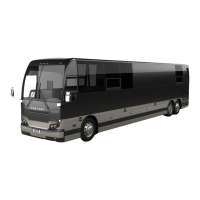
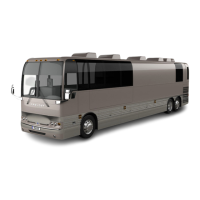


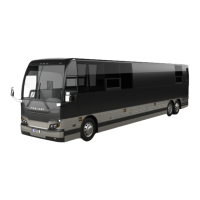

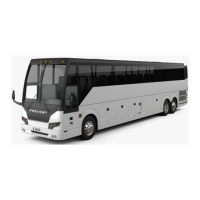
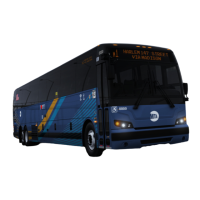


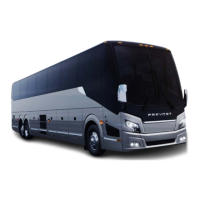
